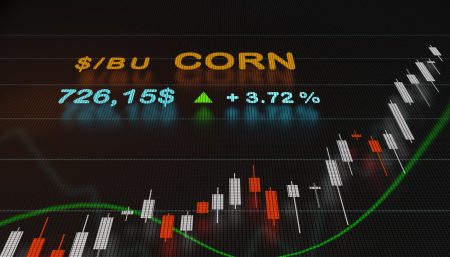Etsy, Inc. (NASDAQ:ETSY) 52nd Annual J.P. Morgan Global Technology, Media and Communications Conference Call May 21, 2024 11:30 AM ET
Company Participants
Josh Silverman – Chief Executive Officer
Conference Call Participants
Katy Ansel – JPMorgan
Katy Ansel
All right. We’re going to get started. I’m Katy Ansel, an Internet analyst at JPMorgan. We’re pleased to have with us, Etsy CEO, Josh Silverman.
Etsy operates two-sided online marketplaces that connect buyers and sellers around the world. etsy.com is the global destination for unique and creative goods made by independent sellers. The company connects over 90 million active buyers with over 9 million connected sellers in nearly every country in the world. Etsy’s primary form of monetization is through marketplace services. The company is on track to generate nearly $13 billion of GMS in 2024 per Bloomberg Consensus Estimates, with $2.8 billion of revenue.
Josh has been CEO for seven years now. And prior to joining Etsy, he held senior leadership positions at American Express, Skype and eBay. Welcome, Josh.
Josh Silverman
Thank you. Thanks for having me. And I’ll just would refer folks to our safe harbor on our website.
Question-and-Answer Session
Q – Katy Ansel
Perfect. So, jumping right in, I mean, looking at recent trends, the macro backdrop has been fairly volatile over the past year-and-a-half or so. So, can you just talk more broadly about the challenges you’ve been facing, what your strategy has been for navigating through them?
Josh Silverman
Sure. And if I can just paint a little bit of context? I’ve been at Etsy seven years now. When I joined in 2017, the conversation about Etsy was it’s about as big as it can be, and there’s a ton of competition and Etsy can’t beat the competition. And at the time, I think we were doing about $2 billion of GMV with maybe $10 million of profit. Last year, we did about $12 billion in the core marketplace of GMV with, call it, $650 million of profit. So, I think we did okay in proving the doubters wrong, and we’re pretty bound and determined to do it again today. I find few things more energizing than proving the doubters wrong.
A little bit of context. More recently, our four-year growth CAGR is 25% on GMS. When you compare that to Amazon, they’re at 11%, Wayfair is 5%, eBay is negative 5%. So, just acknowledging that Etsy has grown a lot. We’ve demonstrated that we’ve been able to grow a tremendous amount of share over a period of time when during the pandemic, people had few other choices and could go almost nowhere else. But since that time, come back and again and again because they’ve loved what they found on Etsy. And I think they’ve been surprised and delighted by how good an experience we have across such a broad array of items.
When I look at this particular macro environment, folks who primarily focus on tech investments say things are great. I’ve invested in Meta and Alphabet and Pinterest and things are great. When I talk to retail investors, they’re like holy cow, its bloodbath out there. So, depending on what sector of the market you look at, consumers are feeling a tremendous amount of pain right now. They’re spending more of their wallet on groceries than they have at any time since the mid-1970s. Rent and mortgages are significantly higher. Gas prices are higher. And there’s a little left over for discretionary goods. So, when they are needing to buy discretionary goods, they are very, very value focused. They’re very focused on things that are 50% off, 60% off. And so, the names that are really growing and gaining share right now are primarily names that focus on selling everyday essentials at very low prices; folks like Walmart, folks like Costco, folks like Amazon. And even Walmart, in its most recent print, they had a great print the other day, and what they said was groceries and skin care are driving all the growth and discretionary goods are down low-single digits, very consistent with what we’re seeing. We were down low-single digits. Even the mighty Walmart in this environment was down low-single digits.
What our data shows is we believe we’re actually holding share. With all the gains we’ve made in share over the past few years, we’re holding share still today, even in this environment against our pure-play competitors in our categories. We are bound and determined to focus obsessively on the things we can control. And I know there’s a lot we can control, particularly, and I’m sure we’ll talk about this more, leaning into what makes Etsy different and making Etsy an even more engaging shopping experience. The solution for Etsy in this environment is not to try to take — chase Temu or Walmart to the bottom on price and discounting. We’ll do a little bit of price and discounting because it’s important. We don’t want to be tone-deaf. But leaning into what makes Etsy different and leaning into making Etsy even more engaging, we think there’s a tremendous amount of value we can unpack.
Katy Ansel
All right. That’s really helpful background. So, I think you alluded to a little bit, but competition has been another big topic in the space. So, I guess, how would you characterize the competitive landscape more broadly? Where does Etsy sit in the e-commerce landscape? And I guess, can you talk a little bit more about what you are doing to differentiate yourself from some of those mass market retailers?
Josh Silverman
Yeah. I mean, at 2017, it was Etsy as big as it can be and it’s never going to grow and Amazon Handmade is going to kill Etsy. And today, it’s Temu who is going to kill Etsy. If I had to pick the polar opposite of Etsy, it would probably be Temu. I can’t think of a brand more different than ours. But we have faced tremendous competition from day one. There is no such thing as a market for handmade, that’s not a thing. No one wakes up in the morning and says, “I want to buy something handmade and anything will do.” I just decorated my living room. I bought a new couch, and I need throw pillows. So, I can go to Etsy for throw pillows. I go to West Elm for throw pillows, I can go to Wayfair for throw pillows, right? Retail is incredibly competitive, and there will always be hundreds, thousands of smart, capable companies competing for a limited share of wallet.
What I love about Etsy is we are one of the very few companies that genuinely is offering you different products and a different buying experience. Virtually everyone else is selling you literally the exact same item at what they hope to be a slightly cheaper price or shipped slightly faster. And that is a race to the bottom, that’s difficult to create sustainable competitive advantage in, and I wish those folks the best. We are offering you something truly different. And you can buy that throw pillow mass produced from someone else at a super cheap price or you can buy it on Etsy at a fair price, and when someone comes in and complements you on it, you say, “You know what, I bought that from a maker in Turkey. Her family has been hand-making those textiles for three generations. She and I now trade dog photos.” Like, real story actually that’s happened with my wife and I with a seller in Turkey. It comes with a story. It comes with a sense of belonging. It comes with an expression of your sense of taste and style.
So, we are, I think, offering you something really different and in a way that feels much more human. And the more we have that race to the bottom on commoditized commerce, the more people are going to crave something really different. And ultimately, there’s only a few brands — lots of brands will compete. There’s only a few brands that can win in commerce. Because you can’t remember that many brands. So, you’ve got to go to Google, you’ve got to go to Meta or somewhere else to find all these brands. And as soon as that’s true, all of your margins are gone. There’s a handful of brands you can truly remember. I believe Etsy is right now about the third most popular e-commerce site in America measured by active buyers. Only Amazon and Walmart had more in e-commerce than Etsy. Etsy is a brand people know and they love. And we’re going to continue to invest in that. And I think over time, the market will consolidate and we will be a winner.
Katy Ansel
All right. That’s helpful. I know you mentioned two key strategies for the year, focusing on your differentiation as well as improving engagement with your active buyers. So, can you talk a little bit more about the strategy for engaging those active buyers?
Josh Silverman
Yeah. Etsy for the longest time, for the prior seven years, my seven years with the company, we’re really obsessed about in-session conversion. We’ve made the experience much better. If you know what you want when you come to Etsy, we’ve gotten vastly better at getting you to that thing. There’s more than 100 million things for sale on Etsy. That turns out to be a really hard computer science project. But if you can imagine it, we have it for sale. In fact, we probably have 10,000 versions literally of that thing. Our challenge is how do we get you to the best one. And we focused a lot on that. We’ve made a lot of progress.
That still requires quite a lot of imagination. What we find is many of our consumers will have gone everywhere else and not found it, and then they come to Etsy. Our opportunity is to help you find things you didn’t even know you wanted. To get earlier in the process with you to show you things that are surprising, delightful, engaging, that you didn’t realize you wanted, to take, go on offense against entertainment shopping, against window shopping, where because we have 100 million things, so many of them beautiful, handcrafted, delightful, how do we elevate the things that are the best of Etsy and spend more time engaging you in fun shopping experiences. So, we’re not just competing for dollars for the time you know you want something, we’re going to compete for time when you just have five minutes to spare. There’s so much we can do at Etsy right now to surprise and delight you and make that experience really entertaining, and we’re going on offense there.
Katy Ansel
Okay. That’s a helpful backdrop. So, I guess, just looking at kind of your outlook for the rest of the year, you have talked about modest improvement in GMS through the second half of the year. So, can you just talk to about kind of what gives you confidence there? And what exactly is factored into this view?
Josh Silverman
Yeah. So, we’re not macroeconomists, and times have been volatile. Month-to-month, that is still very volatile on the site. What I will say is that we have a great product roadmap I’m super excited about, in things that really lean into differentiation and really lean into engagement. And those initiatives stack through the year. So, Gift Mode, for example, which we launched in late February, we’re really encouraged by the start that it’s off to. Gifting is a wonderful occasion that is so well set for Etsy. When you’re buying a gift for someone, you don’t want to say, “Where’d you buy it? Oh, I bought it on Temu, or I bought it on Walmart.” All due respect to those brands, it’s probably not how you want to present yourself. “I bought it on Etsy, and it’s made just for you,” that’s a case we really should and could win. And gifting, we think, is a huge market.
So, we launched it in late February. And just over the past couple of weeks, we’ve launched Wishlists. So, you can, for each person, you gift for, create a dedicated wishlist for them. We’ve created video in the gift notifications. You can take a video of yourself and have that be sent to the gift recipient along with the item, so you can tell them a story of why you care for them or what the item is about. We’re making that better and better. And we’re doing a lot right now to elevate the very best of Etsy and the more engaging, fun and inspiring things in a way that I believe is going to pay off and yield incremental growth as we move through the end of the year, accelerate at least relative to Q1.
Now, things could get worse in the macro environment, things could change. So, we’re not economists. We don’t know, but I’m excited about the roadmap and believe it will lead to us growing faster in the second half of the year than we did in the first quarter.
Katy Ansel
All right. That’s helpful. So, sticking with Gift Mode for a second. Can you just remind everybody how we should think about sizing this opportunity? It sounds like there’s a lot going on here. Clearly, gifting is a core use case for Etsy customers. So, how big do you think this opportunity can become over time?
Josh Silverman
Yeah. We think the average American consumer, just starting with the U.S., spends about $1,600 per year on gifts. And if they shop on Etsy already, we think we’re getting less than 5% of that. And that’s only for our existing buyers, not to mention all the people for whom they haven’t shopped on Etsy recently, and we think gifting is a fantastic use case. We think gifts is about a $400 billion market. When you take out things we don’t compete in, like flowers and chocolates, we think it’s about a $200 billion market that we have maybe 5% of. And again, we think we have a highly differentiated offering here, where we have a lot of right to win.
So, Gift Mode, we launched as an MVP in late February. It’s going to keep getting better and better, and we’re going to keep marketing. Still most of our consumers still aren’t aware of Gift Mode, but fundamentally buying for someone else is different than buying for yourself in a whole bunch of ways. And I think we can create a really differentiated experience, really build awareness and really give people a reason to come or come back to Etsy a lot more often. And even last quarter, we shared that gifting grew in the low-single digits on Etsy, where Etsy overall shrank about 5%, and we think our pure-play gifting peers shrank much more than 5% in that quarter. So, we think we’re already seeing differential growth.
And by the way, gifting is not the only place where we have occasions we think we can really own and win. But we think it’s a great first use case to build a dedicated vertical experience and then grow from there.
Katy Ansel
Okay. That’s helpful. I think your Gift Mode launch was definitely pretty interesting. It seemed like it was kind of a bigger launch, maybe a shift in strategy for how you’ve been thinking about and running the business over the past couple of years. So, I guess can you talk internally how you guys are approaching project work and innovation and how your — is this going to be the future of Etsy, these kind of bigger launches? Or are you still going to do more A/B testing like you’ve typically done?
Josh Silverman
Thank you so much for that question. We had an executive team offsite at the beginning of the year, where the theme was — we as an executive team have been working together for quite some time. I think it’s a really high-quality team, and I’m proud of the fact that we’ve got a lot of tenure on it. But the theme was, today is your first day. And how do you — what do you observe about the business and what would you do differently? And it was a fantastic conversation. And I think what we came away saying is, we are an incredibly analytical, incredibly data-driven team. And everyone at Etsy is very accountable to a very specific mission, with a very specific goal.
So, Etsy is organized into squads of eight or 10 people. And every single squad is given a GMS, generally, GMS. Some teams have revenue targets or cost-saving targets. Most teams have GMS targets. Improve this experience in a way that unlocks $50 million of GMS. And every month, they’re held to account. And as a result, teams are very focused on incremental improvements in existing experiences. And that has moved Etsy’s customer experience far forward over the past seven years. I’m very proud of it. I’m glad we did it. But it is not what is going to take us to the next level.
So, there is — if we think of that as sort of very much the Google model of small incremental improvements every single week, so that over the course of six months, it got way better, but you might not have noticed. There’s another model, which is maybe more the Apple or the Airbnb model, which is we’re going to do a few big-bang launches, and we’re going to ship a whole bunch of things all at once, and we’re going to do a big marketing campaign and tell you about it. Gift Mode is a first example of us, at least in my tenure, doing something more along the lines of what an Apple or an Airbnb would do.
And Etsy wouldn’t normally do Gift Mode all at once. We would have broken that into 30 pieces and tested every single one of those 30 pieces in A/B test. And then, we would have separately launched a marketing campaign, so we could measure every part of that marketing campaign. We did it all at once. The advantage of that model doing it all at once is you wake people up to the fact that there’s things about Etsy that they don’t know. People think they know and you tell them, oh there’s something brand new here that you should come for. We think there’s value in that. And we think there’s value in building a holistic experience that’s beautiful, where maybe we haven’t A/B tested every single pixel. We’ve instead built something that we know is going to be gorgeous and engaging, and it’s the place we want to shop and leading customers to that.
So, we’re not moving entirely from one mode to the other. There’s still a lot of work at Etsy that is making an existing experience incrementally better and measuring value along the way. But you’ll see more of us launching more disruptive experiences that we think wake people up more to all the things about Etsy that they — we want them to know that they don’t currently know.
Katy Ansel
All right. That’s an interesting pivot you guys are making. So, helpful context there. You talked a little bit about your marketing strategy with Gift Mode. So, I do want to hone in on marketing more broadly at Etsy. Can you just talk about your approach here? How the recent competitive landscape has impacted your approach? I think that’s been a big topic in recent quarters as well.
Josh Silverman
Yeah. I mean, where we have performed especially well has been historically Google PLAs. I think we are one of the more sophisticated Google PLA buyers. And if you think about what we’ve done very well over the past few years is if you know exactly what you want, we get you there. And Google PLA is a very high-intent channel where you type into Google exactly what you want, we show you that throw pillow. And then you come to Etsy, you land on it and we help you buy it.
The opportunity for us — the other place actually, that’s done well for us is television, where we have been very ROI-focused on TV, but we’re happy with the returns we see. And again, where you’re building a brand that millions of people love and want to come to again and again, over time, I believe there will be a lot of consolidation in e-commerce, there’s only going to be a few brands people love and remember, and Etsy, we think, is one of them. We fully intend that we’re going to be a winner in that consolidation play and TV is very helpful.
But there’s a big space in the middle, which is mid-funnel, what we call mid-funnel. What do we mean by that? You are a pet owner or you are having a lot of your friends get engaged. And so, you’re in the middle of a whole bridal thing at a certain time of life, right? That’s not a very specific product. Cake toppers — wedding cake toppers, we’re awesome at wedding cake toppers. But generally, I am getting married and there’s 50 things that I need. What’s the right creative to get you there and what’s the right landing experience to convert. We are, I would say, quite immature in our journey there. And the kinds of places where you’d lean into are things like Meta or YouTube are places that are maybe better at the mid-funnel. I think there’s a lot of opportunity for us to do better.
So, people generally are now — in our biggest markets like the U.S. and the U.K., generally aware of Etsy and generally love Etsy. How do we help you to be more aware of Etsy and more occasions in your life? Gift Mode, one example, but mid-funnel marketing, I think, is another big opportunity for us.
Katy Ansel
All right. That’s helpful. I want to pivot a little bit to something you were talking about earlier, which is the fact that there’s just so many product listings on Etsy, over 100 million. And quality, I think, has been another big focus of yours. So, can you talk just a little bit more about some of those initiatives to improve quality and help connect users to the right products at the right time? And maybe how you’re leveraging AI and machine learning to help with that process?
Josh Silverman
Yeah. It’s a huge opportunity, and I’m incredibly excited about it. I’m going to talk about quality and then I want to talk a little bit about curation and elevation. So, in quality, if you’re a seller on Etsy, the number one thing you want to know is how do I rank higher in search. And if you go and you Google that, you’re going to see tons of videos people have put out there that are all basically about how can you SEO your search on Etsy. It’s mostly keyword stuffing. That is not how we want you to earn a place on the top of Etsy. And frankly, there has been a lot of how you could earn your way to the top of Etsy in the past. But for most searches, we’re going to have 10,000 relevant items, and there’s going to be maybe a couple hundred that are very, very similar.
So, how should you earn your way to the top of search? Well, let’s start with, you consistently ship on time and people are always delighted with the item and give you 5-star reviews. You leave that handwritten note. You respond to conversations, buyer convos quickly. Your shipping prices are appropriate. You offer a good return policy. There’s a few things that buyers really care about. And what we want is for you to earn your way to the top through delivering really delightful items and a really delightful customer experience. That’s how you should earn your way to the top. So, we are hard at work exposing to sellers our view of how they’re doing across a number of quality metrics. And then having sellers understand that by improving in those quality metrics, they will earn a higher spot on search.
Now, it’s says easy, does hard, because what we have today is a black-box model that is not explainable. But is very good at predicting of the 100 items that are very similar, which one is likely to convert the best. We need to create an explainable model that comes close enough to that black-box model. It may not be quite as good, but close enough, because even if it’s not quite as good as the black-box model, the virtuous cycle of being able to have sellers know how they’re doing on quality and compete based on quality creates a race to the top that lifts the whole buying experience, which will lift the whole selling experience and make Etsy way better.
So, we’re hard at work. Now, our search team is on creating that explainable model and the seller team is on creating the dashboards. And you will see us, by the end of this year, start to make progress in that. I think that, that is a major unlock on Etsy that I think is going to make the whole experience better for both buyers and sellers. Of course, it’s going to be better for buyers. But sellers also feeling a sense of agency that she knows what she can do every day to rank higher, I think, is going to be very important.
In addition to quality, we have an opportunity to do a better job curating and organizing. We are very focused on suppressing and eliminating items that do not belong on Etsy. That’s a hard task. Is it handmade or not? But gains in AI have really helped us to be able to get more accurate models, to determine whether something complies with our policy or not. Simple thing is now that were very hard a few years ago, like does the same image exist on Alibaba Express or Temu. If it does, by default, we automatically take it down. We have automated scrapers that are constantly looking at that and taking things down that we think don’t belong. And we said we have about a 50 basis point headwind right now, just from all of the things we’re removing. We’re removing millions of listings. We have removed millions of listings and tens of thousands of sellers. It’s very important that the only things on Etsy are things that truly comply with our policy and belonging.
Elevating then the best of Etsy. Part of that is the quality initiative that I’ve spoken about, but also just sourcing, what are the most beautiful, what are the most artisanal, what are the most handcrafted things on Etsy, which you may or may not be ready to buy right now. But remind you and anchor you in the difference of what Etsy stands for. We can do so much more to bring that stuff to the surface and really help you to see it. And then, for the rest, curating and organizing it. So, you understand different items on Etsy comply with different parts of our policy, be it handmade, be it designed by the seller, be it vintage, we can organize this stuff better. So, you understand what you’re seeing, why you’re seeing it and have cleaner shopping aisles. Things like when you’re buying jewelry, when you walked into a jewelry store, you’d never see costume jewelry and fine jewelry sitting right next to each other on the same shelf. But on Etsy, it’s all mushed together. We have a big opportunity to organize better.
And AI, and in particular, GenAI is going to be incredibly helpful for us. For most e-commerce companies, they just need to create a taxonomy and then everything — have everything mapped to a taxonomy. But with over 100 million items in almost every category imaginable, that number of taxonomy would be very difficult in trusting a seller to know where to place their item in that taxonomy would be incredibly difficult. GenAI suddenly, we’re in a world where you can ask GenAI, what would be a taxonomy to organize this particular area? And where would this item fit? And it’s getting better and better at doing a good job of that. That, I think, is going to be a big unlock for us.
Katy Ansel
All right. That’s helpful. So, you talked a little bit about tools for sellers. Another lever that you guys could pull to support top-line growth would be to actually increase some seller fees. So, can you just kind of talk about your strategy more broadly here, and the puts and takes that you would consider when thinking about changing the fee structure?
Josh Silverman
Yeah. I mean we’re always focused on a fair exchange of value. And we want to make sure that sellers were getting a fair deal, buyers were getting a fair deal and shareholders were getting a fair deal. We did a big — we did a headline-grabbing take rate increase in 2022. And I think it was a really good decision, and we raised fees a little bit, 1.5%. We reinvested the substantial majority of that back in sellers, mostly in marketing. And one of the reasons why Etsy sales held up so much better than most other people in 2022 is because we’ve been able to increase our investments in marketing. It’s one of the reasons why we’ve retained almost all of our pandemic gains where most people haven’t. So, we’ve shown a willingness to do that when we know we’re driving value for the whole ecosystem.
But you’ve also seen our take rate go up in many years when we haven’t had a headline-grabbing take rate increase. So, you’ll notice our take rate guide for this year is meaningfully higher than it was last year. And that is through things like Etsy Payments and Etsy Ads that continue to get better where coverage continues to expand and sellers are opting into value-added services that do great things for them and make the whole ecosystem better. So, I think we continue to have a lot of opportunity to add new services, make our current services better and doing so, have a fair exchange of value.
Another recent example is we just launched a $15 fee, an onboarding fee, for new sellers. Many, many people, hundreds of thousands of people a quarter want to come and open a shop on Etsy. We want to know that you have the skill and will to do so and being willing to pay a $15 fee is one example of making sure that the people who are joining have the skill and will to be worth us investing and supporting and we reinvest that in biometric authentication for those new sellers, so that their accounts are more secure. So, we’re going to keep looking for opportunities like that.
Katy Ansel
All right. That’s helpful. You talked a little bit about on-site advertising, and that’s been a bright spot and contributor to the top-line. So, is there anything else you can share just on maybe the percentage of sellers that are leveraging Etsy Ads or what key initiatives we should be on the lookout with regards to the service?
Josh Silverman
Yeah. So, Etsy Ads has grown year after year. Most of the large sellers that should be part of the Etsy Ads program are part of the Etsy Ads program. So, adding more sellers into the program is not the biggest lever. Getting them to increase their budget can be, many sellers give us much more budget than we’re able to spend. Some sellers don’t give us as much budget as we think we could spend. So, having some sellers increase their budget is part of it. Most of it is just getting the algorithms to be better and better, picking the right ad to show at the right time. And it’s a problem that’s very similar to the search problem.
For any given search query, we have hundreds of listings that are all paid, that have opted into our Etsy Ads program and have budget available, which is the one that’s most likely to convert? And as our ML technology gets better and better and better at that, we pick the right ad, that, by the way, is aligned with buyer experience as well. It makes the buying experience better. It makes the selling experience better. It drives ROAS for the sellers and it drives ad revenue for us. And the gains you’ve seen us make in Etsy Ads, the largest driver of those gains is our algorithms just get better at picking the right ad. And so, we are generating more revenue. The seller is also getting more ROAS and it’s a win-win-win.
Katy Ansel
All right. So, sticking with ads, one more on that topic. But can you just remind us how offsite advertising works? And why this might be beneficial to Etsy and its sellers?
Josh Silverman
Sure. So, for offsite advertising, the best way to think about that is a co-op program between Etsy and its sellers. We have a fee where, if someone — a buyer goes to Google, searches for a Turkish throw pillow, lands on that Turkish throw pillow on Etsy and buys it, there’s an incremental 15% take rate. And so, what that is, is that’s basically the seller and Etsy sharing the cost of that PLA. And that offsite ads program offsets a portion of our Google Ads. Etsy still spends well more than half of the money comes from Etsy. But sellers are now contributing a meaningful portion of that through the offsite ads program, and we think it’s been very successful, very helpful for sellers to drive more sales and for Etsy to be able to invest more in performance marketing channels.
Katy Ansel
All right. That’s great. I want to pivot to your investments and how you’re thinking about that for the year. I know you guys did a restructuring late last year. So, can you just talk a little bit more about what you were trying to achieve and how that factors into Etsy’s performance, key priorities for the year, maybe opportunities to better leverage AI, just how you’re kind of thinking about all those puts and takes?
Josh Silverman
Sure. I’ll just start by saying every year for seven years has been a year of efficiency for Etsy. There’s never been a year that wasn’t a year of efficiency. We have always scrutinized every month and every quarter, every dollar we spend. And I think we’re unusually good at taking a squad that’s been working on something for a little while and deciding that’s not paying off and picking them up and moving them to something else. That’s why we said before the restructuring, we thought the payoff, the fully loaded payoff time for our product — for our — sorry, product and engineering investments was less than 18 months. Now, after the layoff, I would say, it’s shorter than that. So, we think we’re getting a very good ROI on that.
Our focus — and then, on marketing, our focus has always been on the next dollar spent. We spend quite a bit of time trying to map the marginal return curve in each channel in Google, Facebook, Pinterest, television, if we spent another dollar, what would be the ROI on that, and making sure that we’re getting a good return on every dollar spent. We’re constantly investing in martech to do better. Where are the big investments we’re making this year? Broadly speaking, making Etsy more differentiated and making Etsy more engaging are the big themes. I think there’s a ton of opportunity.
Machine learning plays a very big role in that. I would say we’re not new to that. A lot of the work that I talked about for making Etsy, taking what you said you want and showing you that on Etsy, that’s been the work we’ve been doing for years. So, for example, if you type in at Etsy cocktail attire for men, you’ll see a lot of sport coats, even though sport coats are not — none of the words are in common. We understand the difference between a wedding dress and wedding dress hanger, for example, which is a very complicated thing for a computer to understand and the technology that underpins that is something called a neural network translator, which you’ll all be familiar with because that’s now what GenAI is. But we’ve been doing that for several years now.
So, leaning into GenAI to help us organize the buying experience a lot better, I think, is a huge opportunity. If you go to the Etsy app today, next to the search bar, you’ll see a little icon. You can click on that and you can engage with the shopping assistant on Etsy, who will help you shop on Etsy. And that shopping assistant will say, “What are you looking for today?” And you’ll say, “My friend is getting married, and I need a bridesmaid gift.” Oh — it will help take you through that, the same way that a sales agent in a store would do that. In a normal story, you don’t choose from 100 million things. So, if that sales agent is a little bit helpful in a normal store, I think over time, it’s going to be incredibly helpful on Etsy. But customers are still getting used to these chatbots. And it turns out the chatbot technology is well ahead of what customer adoption is ready for. Over time, I think that’s going to be incredibly helpful for us where I think we’re going to see even more value is in having that GenAI organize and curate Etsy in a way that we would have to hire 100,000 employees to do without it.
The last thing I’ll say about machine learning is just we’ve been investing a lot in democratizing ML. Every single squad in Etsy has demand for ML. So, we’ve been building a lot of tools to allow any full stack engineer to do relatively advanced machine learning without a lot of handholding from a data science team, and that’s driving a lot of productivity right now as well.
Katy Ansel
All right. We have about a minute left, so we’ll try to keep this one brief. But just kind of putting it all together, your outlook for 2024 is, you’re targeting adjusted EBITDA margins at least similar to 2023 level. So, can you just talk about some of the levers you pull to the extent maybe macro does not improve as the way you’re expecting?
Josh Silverman
Yeah. Shareholders have been saying, hey, growth has been decelerating for the last couple of years and margins have been declining. I will say the core Etsy business is delivering a 30% EBITDA margin. I don’t know of any marketplace business, anything in a similar scale to us that has a 30% EBITDA margin. If you look at the companies that are similar in scale to us, their EBITDA margins are much lower. That said, I don’t think that’s an unreasonable ask. What we said is, we have every expectation to be able to hold margins to at least what they were last year. And we are always, always looking for efficiencies within the company to make sure that every dollar works super hard. Over time, what’s going to get the stock where it should be again is growth to drive the multiple. I believe the best days are ahead of us. I think that e-commerce will consolidate. I think Etsy will be one of the few brands that is really out there, taking a lot of share, and we’re very focused on growth.
Katy Ansel
All right. We’ll leave it there. Thanks so much, Josh.
Josh Silverman
Thank you.
Read the full article here















